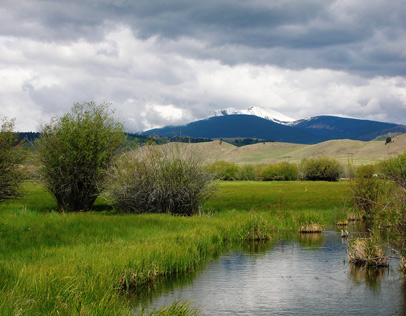CONSERVATION BANKING
A conservation bank, sometimes referred to as a mitigation bank, consists of land that has been permanently preserved and managed for its natural resource values, with the intent that “mitigation credits” may be sold to either private or public parties that are required by law to provide mitigation for impacts to:
- aquatic/stream habitat
- wetland habitat
- riparian shrub and forest habitat
- threatened and endangered species habitat(e.g., Preble’s meadow jumping mouse)
- water quality
Although this concept is new to some, these banks are gaining popularity for their ability to conserve large tracts of land while generating income for landowners. A conservation bank may be integrated with other land uses, including mining, agricultural, commercial, residential as well public open space and natural areas. The goals and objectives of a mitigation bank can be coordinated and synchronized with the goals, objectives and needs of the land owner and therefore does not preclude the continued use and enjoyment of the land.
Mitigation banking does not encourage impacts to wetlands, waterways, or threatened and endangered species habitat!
Federal regulatory programs such as the Clean Water Act (CWA) and the Endangered Species Act (ESA) require that a permit applicant provide proof that they have done everything feasible to avoid and minimize impacts before a project will be considered or authorized by the U.S. Army Corps of Engineers (USACE) or U.S. Fish and Wildlife Service (USFWS). Once that burden of proof is satisfied, then the applicant must provide mitigation for any unavoidable impacts either in the form of on-site mitigation, off-site mitigation or a mitigation bank.
Permit applicants prefer to use conservation banks as they reduce the costs and delays associated with the permit review process, habitat design, construction, long-term maintenance, and monitoring. Regulatory agencies and the environmental community also prefer conservation banks as these large-scale projects are generally more ecologically valuable and functional than smaller, scattered and individual permittee-responsible mitigation projects that often fail.
Many degraded lands hold potential to become habitat conservation banks, such as:
- streams and creeks polluted and eroded by livestock
- mine or brownfields
- urban blight
- major rivers dammed or channelized by early industry
- wetlands which have been clear-cut, ditched and drained
Conservation banks improve and protect land, water and habitat by physically restoring waterways and wetlands, enhancing habitat, establishing native vegetation to duplicate historic conditions, and then permanently protect these valuable resources with a conservation easement. Other benefits of conservation banks are:
- Costs for planning, design, construction, accreditation and maintenance are borne by the mitigation bank;
- Restore or enhances degraded aquatic, wetland and riparian habitat and increases land value that a land owner might not be able to afford otherwise;
- Creates aquatic, wetland and riparian habitat;
- Provides real financial incentives for land owners to participate in the conservation and development of the bank;
- Can help the land owner avoid having to sell their land legacy; and
- Eases the burden on the regulated community (private and public) to develop and improve infrastructure by providing one stop shopping for mitigation.
Conservation banks are designed to protect resources in advance of mitigation needs, and are considered a useful tool in efforts to conserve wetlands, waterways, and threatened and endangered species habitat. To establish a conservation bank, a landowner can voluntarily conserve or create habitat in anticipation of a future sale of mitigation credits to those who need it. Proposed banks must comply with the mitigation banking policies of the CWA and ESA and must receive agency approval. The monetary value of credits will depend on the supply and demand of mitigation land.
Ecosystem Services has partnered with Restoration Systems, LLC, a national mitigation banking firm to help meet the future demand for conservation banks in Colorado. Contact Ecosystem Services if you are in need of mitigation or if you are a land owner and would like to reap the benefits of having a bank on your land.










